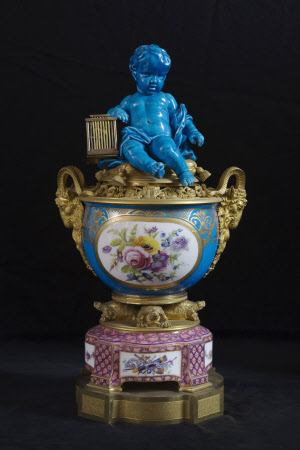Pot pourri vase
probably Edward Holmes Baldock (1777 - 1845)
Category
Ceramics
Date
1760 - 1820
Materials
Ormolu, Porcelain
Measurements
480 mm (Height)
Order this imageCollection
Uppark House and Garden, West Sussex
NT 137434
Summary
Vase potpourri, porcelain and ormolu, a seated putto, porcelain, holding a gilt metal birdcage, raised on a chamber pot (handle missing), porcelain, painted with oval reserves of floral bouquets on a bleu celeste ground, with two ormolu rams’ head handles and on three gilt metal tortoise on a stand, soft-paste porcelain, rose marbre ground with swags in reserves and a trophy of a bow and quiver inscribed ‘OMNIA VINCIT AMOR’,. Elements made by the Sèvres porcelain factory, France, part dated 1761, and assembled c. 1820, probably in the London workshop of Edward Holmes Baldock (1777-1845).
Full description
Vase potpourri, Sèvres porcelain and ormolu, a seated putto, porcelain, after a marble by Antoine Pajou (1730-1809), with a later turquoise glaze, holding a gilt metal birdcage, raised on a chamber pot (handle missing), porcelain, painted with oval reserves of floral bouquets on a bleu celeste ground, with two ormolu rams’ head handles and on three gilt metal tortoise on a stand, soft-paste porcelain, rose marbre ground with swags in reserves and a trophy of a bow and quiver inscribed ‘OMNIA VINCIT AMOR’ from Virgil’s Ecologues, painters mark for Binet and date letter for 1761 and assembled c. 1820, probably in the London workshop of Edward Holmes Baldock (1777-1845). The plinth was designed as a base for the biscuit figure by Falconet, ‘L’amour menaçant’. Sir Harry Fetherstonhaugh (1754-1846), grew up surrounded by fine German, English and Chinese ceramics, and became one of the great English collectors of French porcelain purchasing for the future George IV. He visited Paris during the Peace of Amiens in 1803, and returned when the conflicts in France had ended, in 1819 and 1824. The ceramics specialist Anthony du Boulay(1929-2022) provides a detailed assessment of the French porcelain, which once graced Uppark. ‘Like other rich British landowners of the period, he [Sir Harry Fetherstonhaugh] profited from the sale after the French Revolution of Royal and Aristocratic collections. He had obviously acquired a reputation as a connoisseur and many of his Sèvres vases had their counterparts in those pieces bought by the Prince of Wales, later George IV, which are still in the Royal Collection. While one of the Prince’s other advisers was Lord Yarmouth, later 3rd Marquess of Hertford, whose collection of French furniture and Sèvres porcelain was far larger than Sir Harry’s, most of the Sèvres in the Wallace Collection with counterparts in the Royal Collection was, in fact, bought a generation later by the 4th Marquess of Hertford’.[1] By 1809, almost £20,000 had purportedly been spent on china and furniture, so wrote John Webb, the author of the Inventory and Sketch of Sundry Sèvres Vases &c. now at Uppark, 1859, now in the Victoria & Albert Museum archives. Many of the most admired Sèvres garnitures in the collections of the Louvre, the Getty Museum, the Huntington and other American museums were at one time owned by Sir Harry and displayed at Uppark. Some of these ceramics were 18th century pieces, which for various reasons, damage or fashion, had been later decorated or reassembled in combination with ormolu mounts of fine quality dating to the Restauration, c. 1800-30. As du Boulay points out, already by 1859 scholarship had identified these ‘improved’ objects and therefore, they were not described in detail, nor appraised or offered for sale in 1910-11.[2] However in the early 19th century, when seen collectively, Sir Harry was somewhat indiscriminate, buying some of the finest objects produced by the Sèvres factory alongside many “improved” objects. Faced with a veritable treasure trove of French porcelain in the years following the French Revolution, he acquired second-hand objects, in out-of-date styles, guided by those with a historical or aristocratic provenance often with beau bleu grounds enriched with gilding and bronze mounts, a decidedly English Regency taste.[3] Edward Holmes Baldock (1777-1845) was a prominent London furniture dealer to George IV. He was first listed in the London trade directories in 1805, operating out of No.7 Hanway Street in London, where he was described as selling "china and glass". An updated listing in 1821 described his business as "an antique furniture and ornamental furniture dealer", and in 1826 as a buyer and seller of "china, cabinets, screens, bronzes etc". [1] Anthony du Boulay, ‘French Porcelain at Uppark; a re-assessment,’ French Porcelain Society, XV, 1999, p. 11. [2] The first publications on French porcelain was by Alexandre-Théodore Brongniart (1739-1813), Traité des Arts Céramiques ou des Poterie, Paris, 1844. [3] Rowell, Christopher, ‘A Sèvres biscuit centrepiece by Alexandre-Théodore Brongniart restored to Uppark’ Apollo, cxlix, April 1999, pp. 54-7, p. 57. Provenance: Listed in Inventory and Sketch of Sundry Sèvres Vases &c. now at Uppark, 1859 by J Webb (V&A Museum) with a sketch and note ’the centre part belonged to Madame Dubarry’ Margaret Meade-Fetherstonhaugh and Oliver Warner, Uppark and Its People, (London, 1964), p. 70. Sir Harry was able to acquire…a Sevres vase of great beauty, garlanded with flowers in the Pre-revolutionary style. This had been added to: A cover of gilt ormolu, on which was enthroned a Cupid holding a captive dove in a cage surmounting it. The vase was supported by ormolu tortoise, the juxtaposition of two in harmonious styles in a single piece, being startling evidence of current debasement in taste’. Publication: See Anthony du Boulay, ‘French Porcelain at Uppark: a re-assessment,’ French Porcelain Society, XV, 1999.
Makers and roles
probably Edward Holmes Baldock (1777 - 1845), dealer Sèvres Porcelain Manufactory , maker
